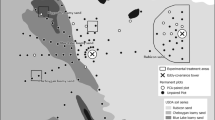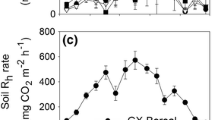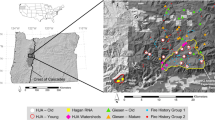Abstract
The low plant productivity of boreal forests in general has been attributed to low soil N supply and low temperatures. Exceptionally high productivity occurs in toe-slope positions, and has been ascribed to influx of N from surrounding areas and higher rates of soil N turnover in situ. Despite large apparent natural variations in forest productivity, rates of gross soil N mineralization and gross nitrification have never been compared in Fennoscandian boreal forests of contrasting productivity. We report contrasting patterns of soil N turnover in three model ecosystems, representing the range in soil C-to-N ratios (19–41) in Fennoscandian boreal forests and differences in forest productivity by a factor close to 3. Gross N mineralization was seven times higher when soil, microbial, and plant C-to-N ratios were the lowest compared to the highest. This process, nitrification and potential denitrification correlated with inorganic, total and microbial biomass N, but not microbial C. There was a constant ratio between soil and microbial C-to-N ratio of 3.7±0.2, across wide ratios of soil C-to-N and fungi-to-bacteria. Soil N-cycling should be controlled by the supplies of C and N to the microbes. In accordance with plant allocation theory, we discuss the possibility that the high fungal biomass at high soil C-to-N ratio reflects a particularly high supply of plant photosynthates, substrates of high-quality C, to mycorrhizal fungi. Methods to study soil N turnover and N retention should be developed to take into account the impact of mycorrhizal fungi on soil N-cycling.


Similar content being viewed by others
References
Beier C, Eckersten H (1998) Modelling the effects of nitrogen addition on soil nitrogen status and nitrogen uptake in a Norway spruce stand in Denmark. Environ Pollut 102:409–414
Binkley D, Hart SC (1989) The components of nitrogen availability assessments in forest soils. Adv Soil Sci 10:57–112
Booth MS, Stark JM, Rastetter E (2005) Controls on nitrogen cycling in terrestrial ecosystems: a synthetic analysis of literature data. Ecol Monogr 75:139–157
Cajander AK (1926) The theory of forest types. Acta For Fenn 29:1–108
Cannell MGR, Dewar RC (1994) Carbon allocation in trees—a review of concepts for modelling. Adv Ecol Res 25:59–104
Carmosini N, Devito KJ, Prepas EE (2002) Gross nitrogen transformations in harvested and mature aspen-conifer mixed forest soils from the Boreal Plain. Soil Biol Biochem 34:1949–1951
Chapin FS III, Fetcher N, Kielland K, Everett KR, Linkins AE (1988) Productivity and nutrient cycling of Alaskan tundra: enhancement by flowing water. Ecology 69:693–702
Chapin FS III, Moilanen L, Kielland K (1993) Preferential use of organic nitrogen for growth by a non-mycorrhizal Arctic sedge. Nature 361:150–153
Dahl E, Gjems O, Kjelland-Lund J (1967) On the vegetation of Norwegian conifer forest in relation to the chemical properties of the humus layer. Meddelelser fra det Norske Skogsforsøksvesen 85:501–531
Davidson EA, Stark JM, Firestone MK (1990) Microbial production and consumption of nitrate in an annual grassland. Ecology 71:1968–1975
Davidson EA, Hart SC, Shanks CA, Firestone MK (1991) Measuring gross nitrogen mineralization, immobilization, and nitrification by 15N isotopic pool dilution in intact soil cores. J Soil Sci 42:335–349
Davidson EA, Hart SC, Firestone MK (1992) Internal cycling of nitrate in soils of a mature coniferous forest. Ecology 73:1148–1156
Davidson EA, Chorover J, Dail DB (2003) A mechanism of abiotic immobilization of nitrate in forest ecosystems: the ferrous wheel hypothesis. Global Change Biol 9:228–236
Eno CF (1960) Nitrate production in the field by incubating the soil in polyethylene bags. Soil Sci Soc Am Proc 24:277–279
FAO (1988) FAO/ UNESCO soil map of the world. Revised legend. (World resources Report No. 60). FAO, Rome
Federle TW (1986) Microbial distributions in soil—new techniques. In: Megusar F, Gantar M (eds) Perspectives in microbial ecology. Slovene Society for Microbiology, Ljubljana, pp 493–498
Finlay RD, Söderström B (1989) Mycorrhizal mycelia and their role in soil and plant communities. In: Clarholm M, Bergström L (eds) Developments in plant soil sciences. Ecology of Arable land-perspectives and challenges, vol 39. Kluwer, London, pp 139–148
Fisk MC, Fahey TJ (2001) Microbial biomass and nitrogen cycling responses to fertilization and litter removal in young northern hardwood forests. Biogeochemistry 53:201–223
Fisk MC, Schmidt SK, Seastedt TR (1998) Topographic patterns of above- and belowground production and nitrogen cycling in alpine tundra. Ecology 79:2253–2266
Frostegård Å, Bååth E (1996) The use of phospholipid fatty acid analysis to estimate bacterial and fungal biomass in soil. Biol Fertil Soils 22:59–65
Giesler R, Högberg M, Högberg P (1998) Soil chemistry and plants in Fennoscandian boreal forest as exemplified by a local gradient. Ecology 79:119–137
Giesler R, Petersson T, Högberg P (2002) Phosphorus limitation in boreal forests: effects of aluminum and iron accumulation in the humus layer. Ecosystems 5:300–314
Hägglund B, Lundmark JE (1977) Site index estimations by means of site properties, Scots pine and Norway spruce in Sweden. Stud For Suec 103
Hart SC, Nason GC, Myrold DD, Perry DA (1994a) Dynamics of gross nitrogen transformations in an old growth forest: the carbon connection. Ecology 75:880–891
Hart SC, Stark JM, Davidson EA, Firestone MK (1994b) Nitrogen mineralization, immobilization, and nitrification. In: Methods of soil analysis, Part 2. Microbiological and biochemical properties. SSSA Book Series. No. 5. pp 985–1018
Högberg P (2001) Interactions between hillslope hydrochemistry, nitrogen dynamics, and plants in Fennoscandian boreal forest. In: Schulze ED, Heimann M, Harrison S, Holland E, Lloyd J, Prentice IC, Schimel D (eds) Global biogeochemical cycles in the climate system. Academic, San Diego, pp 227–233
Högberg MN, Högberg P (2002) Extramatrical ectomycorrhizal mycelium contributes one-third of microbial biomass and produces, together with associated roots, half the dissolved organic carbon in a forest soil. New Phytol 154:791–795
Högberg P, Johannisson C, Nicklasson H, Högbom L (1990) Shoot nitrate reductase activities of field-layer species in different forest types. Scand J For Res 5:449–456
Högberg P, Nordgren A, Buchmann N, Taylor AFS, Ekblad A, Högberg MN, Nyberg G, Ottosson-Löfvenius M, Read DJ (2001) Large-scale forest girdling shows that current photosynthates drives soil respiration. Nature 411:789–792
Högberg MN, Bååth E, Nordgren A, Arnebrant K, Högberg P (2003) Contrasting effects of nitrogen availability on plant carbon supply to mycorrhizal fungi and saprotrophs—a hypothesis based on field observations in boreal forest. New Phytol 160:225–238
Jansson SL, Persson JC (1982) Mineralization and immobilization of soil nitrogen. In: Stevensson FJ (ed) Nitrogen in agricultural soils. Soil Science Society of America Inc., Madison, pp 229–252
Kaye JP, Hart S (1997) Competition for nitrogen between plants and soil organisms. Trends Ecol Evol 12:139–143
Kielland K (1994) Amino acid absorption by arctic plants: implications for plant nutrition and nitrogen cycling. Ecology 75:2373–2383
Kirkham D, Bartholomew WV (1954) Equations for following nutrient transformations in soil, utilizing tracer data. Soil Sci Soc Am Proc 18:33–34
Lahti T, Väisänen RA (1987) Ecological gradients of boreal forests in South Finland: an ordination test of Cajander’s forest type theory. Vegetatio 68:145–156
Martikainen PJ, Palojärvi A (1990) Evaluation of the fumigation–extraction method for determination of microbial C and N in a range of forest soils. Soil Biol Biochem 22:787–802
Merilä P, Smolander A, Strömmer R (2002) Soil nitrogen transformations along a primary succession transect on the land-uplift coast in western Finland. Soil Biol Biochem 34:373–385
Myrold DD (1999) Transformations of nitrogen. In: Sylvia DM, Fuhrmann JJ, Hartel PG, Zuberer DS (eds) Principles and applications of soil microbiology. Prentice Hall, New Jersey, pp 259–294
Nadelhoffer KJ, Aber JD, Melillo JM (1984) Seasonal patterns of ammonium and nitrate uptake in nine temperate forest ecosystems. Plant Soil 80:321–335
Nadelhoffer KJ, Giblin AE, Shaver GR, Laundre JA (1991) Effects of temperature and substrate quality on element mineralization in six arctic soils. Ecology 72:242–253
Näsholm T, Ekblad A, Nordin A, Giesler R, Högberg MN, Högberg P. (1998) Boreal forest plants take up organic nitrogen. Nature 392:914–916
Nilsson LO, Giesler R, Bååth E, Wallander H (2005) Growth and biomass of mycorrhizal mycelia in coniferous forest along short natural nutrient gradients. New Phytol 165:613–622
Nömmik H, Vahtras K (1982) Retention and fixation of ammonium and ammonia in soils. In: Stevensson F (ed) Nitrogen in agricultural soils. Agronomy Monographs 22. ASA, CSSA, SSSA, Madison, pp 123–172
Nordin A, Högberg P, Näsholm T (2001) Soil nitrogen form and plant nitrogen uptake in a boreal forest along a forest productivity gradient. Oecologia 129:125–132
Nylund JE (1988) The regulation of mycorrhiza formation—carbohydrate and hormone theories reviewed. Scand J For Res 3:465–479
Ohlsson KEA, Wallmark H (1999) Novel calibration with correction for drift and non-linear response for continuous flow isotope ratio mass spectrometry applied to the determination of delta N-15, total nitrogen, delta C-13 and total carbon in biological material. Analyst 124:571–577
Olsson PA (1999) Signature fatty acids provide tools for determination of the distribution and interactions of mycorrhizal fungi in soil. FEMS Microbiol Ecol 29:303–310
Olsson P, Linder S, Giesler R, Högberg P (2005) Fertilization of boreal forest reduces both autotrophic and heterotrophic soil respiration. Glob Change Biol doi:10.1111/j.1365-2486.2005.001033.x
Pastor J, Aber JD, McClaugherty CA (1984) Aboveground production and N and P cycling along a nitrogen mineralization gradient on Blackhawk Island, Wisconsin. Ecology 65:256–268
Pennanen T, Liski J, Bååth E, Kitunen V, Uotila J, Westman CJ, Fritze H (1999) Structure of the microbial communities in coniferous forest soils in relation to site fertility and stand development stage. Microbial Ecol 38:168–179
Perakis SS, Hedin LO (2001) Fluxes and fates of nitrogen in soil of an unpolluted old-growth temperate forest, southern Chile. Ecology 82:2245–2260
Prescott CE, Chappell HN, Vesterdal L (2000) Nitrogen turnover in forest floors of coastal douglas-fir at sites differing in soil nitrogen capital. Ecology 81:1878–1886
Read DJ (1986) Non-nutritional effects of mycorrhizal infection. In: Gianinazzi-Pearson V, Gianinazzi S (eds) Physiological and Genetical Aspects of Mycorrhizae. Institut National de la Recherche Agronomique (INRA), Paris
Read DJ (1991) Mycorrhizas in ecosystems. Experientia 47:376–391
Romell LG (1935) Ecological problems of the humuslayer in the forest. Cornell University Agricultural Experiment Station. Memoir No. 170
Romell LG (1938) A trenching experiment in spruce forest and its bearing on problems of mycotrophy. Sv Bot Tidskr 32:89–99
Rygiewicz PT, Andersen CP (1994) Mycorrhizae alter quality and quantity of carbon allocated below ground. Nature 369:58–60
Schimel JP, Bennett J (2004) Nitrogen mineralization: challenges of a changing paradigm. Ecology 85:591–602
Smith SE, Read DJ (1997) Mycorrhizal symbiosis, 2nd edn. Academic, London
Söderström B (1979) Some problems in assessing the fluoresceindiacetate-active fungal biomass in the soil. Soil Biol Biochem 11:147–148
Söderström B, Read DJ (1987) Respiratory activity of intact and excised ectomycorrhizal mycelial systems growing in unsterilized soil. Soil Biol Biochem 19:231–236
Sörensen P, Jensen ES (1991) Sequential diffusion of ammonium and nitrate from soil extract to a polytetrafluoroethylene trap for 15N determination. Anal Chim Acta 252:201–203
Stark JM, Hart SC (1996) Diffusion techniques for preparing salt solutions, Kjeldahl digests and persulphate digests for nitrogen-15 analysis. Soil Sci Soc Am J 60:1846–185
Stark JM, Hart SC (1997) High rates of nitrification and nitrate turnover in undisturbed coniferous forests. Nature 385:61–64
Sterner RW, Elser JJ (2002) Ecological stoichiometry: the biology of elements from molecules to the biosphere. Princeton University Press, Princeton
Swift MJ, Heal OW, Anderson JM (1979) Decomposition in terrestrial ecosystems. Studies in ecology. Blackwell, Oxford
Tamm C-O (1991) Nitrogen in terrestrial systems. Springer, Berlin Heidelberg New York
Tate RL (1995) Soil microbiology. Wiley, New York
Tiedje JM (1982) Denitrification. In: Page AL (ed) Methods in soil analysis, Part 2. Chemical and microbiological properties—Agronomy Monograph no. 9. ASA-SSSA, Madison, USA, pp 1011–1026
Tutin TG, Heywood VH, Burges NA, Valentine DH, Walters SM, Webb DA (1964) Flora Europea, vol I–V. Cambridge University Press, Cambridge
Vitousek PM, Gosz JR, Grier CC, Melillo JM, Reiners WA (1982) A comparative analysis of potential nitrification and nitrate mobility in forest ecosystems. Ecol Monogr 52:155–177
Wallander H, Nylund J-E (1992) Effects of excess nitrogen and phosphorus starvation on the extramatrical mycelium of ectomycorrhizas of Pinus sylvestris L. New Phytol 120:495–503
Wallenda T, Kottke I (1998) Nitrogen deposition and ectomycorrhizas. New Phytol 139:169–187
Wallenda T, Schaeffer C, Einig W, Wingler A, Hampp R, Seith B, George E, Marschner H (1996) Effects of varied soil nitrogen supply on Norway spruce (Picea abies) [Karst]. 2. Carbon metabolism in needles and mycorrhizal roots. Plant Soil 186:361–369
Waring RH, Running SW (1998) Forest ecosystems—analysis at multiple scales, 2nd edn. Academic, San Diego
Acknowledgements
We would like to thank Mr. Ulf Rubinsson for giving us access to his land and Dr. Maud Quist for help in the field. Funding by the Swedish Research Council for Environment, Agricultural Sciences and Spatial Planning (FORMAS), the Swedish Science Council (VR), and the European Commission (project CANIF) is acknowledged.
Author information
Authors and Affiliations
Corresponding author
Additional information
Communicated by Christian Koerner
Rights and permissions
About this article
Cite this article
Högberg, M.N., Myrold, D.D., Giesler, R. et al. Contrasting patterns of soil N-cycling in model ecosystems of Fennoscandian boreal forests. Oecologia 147, 96–107 (2006). https://doi.org/10.1007/s00442-005-0253-7
Received:
Accepted:
Published:
Issue Date:
DOI: https://doi.org/10.1007/s00442-005-0253-7




